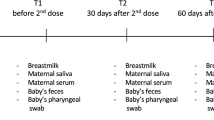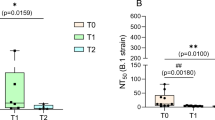Abstract
Histo-blood group antigens (HBGAs) on human intestinal epithelium serve as receptors for noroviruses (NVs). These antigens also are expressed in milk and may act as decoy receptors to protect breast-fed infants and others against NV disease. In this study we demonstrated that human milk is highly variable in synthesis of HBGAs, which differs from that of saliva; a large quantity of small, soluble HBGAs are found in milk, but much less in saliva and are recognized by MAbs, but not by NVs. There is another group of HBGAs, of high MW, found in both milk and saliva, and recognized by both NVs and MAbs. These results suggest that the specificity of NVs and MAbs to HBGAs are different and the backbones in addition to the carbohydrate moiety are required for NV recognition. Further studies to define the structure and genetics of the high MW milk glycans are necessary.








Similar content being viewed by others
Abbreviations
- NVs:
-
noroviruses
- HBGAs:
-
histo-blood group antigens
- FPLC:
-
fast protein liquid chromatography
- MAb:
-
monoclonal antibody
- TFMS:
-
trifluoromethanesulphonic acid
- DTT:
-
dithiothreitol
- mAU:
-
milliabsorbance unit
References
Zheng, D.P., Ando, T., Fankhauser, R.L., Beard, R.S., Glass, R.I., Monroe, S.S.: Norovirus classification and proposed strain nomenclature. Virology 346, 312–323 (2006). doi:10.1016/j.virol.2005.11.015
Lew, J.F., Petric, M., Kapikian, A.Z., Jiang, X., Estes, M.K., Green, K.Y.: Identification of minireovirus as a Norwalk-like virus in pediatric patients with gastroenteritis. J. Virol. 68, 3391–3396 (1994)
Lew, J.F., Kapikian, A.Z., Valdesuso, J., Green, K.Y.: Molecular characterization of Hawaii virus and other Norwalk-like viruses: evidence for genetic polymorphism among human caliciviruses. J. Infect. Dis. 170, 535–542 (1994)
Lambden, P.R., Caul, E.O., Ashley, C.R., Clarke, I.N.: Sequence and genome organization of a human small round-structured (Norwalk-like) virus. Science 259, 516–519 (1993). doi:10.1126/science.8380940
Jiang, X., Graham, D.Y., Wang, K.N., Estes, M.K.: Norwalk virus genome cloning and characterization. Science 250, 1580–1583 (1990). doi:10.1126/science.2177224
Lew, J.F., Kapikian, A.Z., Jiang, X., Estes, M.K., Green, K.Y.: Molecular characterization and expression of the capsid protein of a Norwalk-like virus recovered from a Desert Shield troop with gastroenteritis. Virology 200, 319–325 (1994). doi:10.1006/viro.1994.1194
Jiang, X., Wang, M., Graham, D.Y., Estes, M.K.: Expression, self-assembly, and antigenicity of the Norwalk virus capsid protein. J. Virol. 66, 6527–6532 (1992)
Jiang, X., Matson, D.O., Ruiz-Palacios, G.M., Hu, J., Treanor, J., Pickering, L.K.: Expression, self-assembly, and antigenicity of a snow mountain agent-like calicivirus capsid protein. J. Clin. Microbiol. 33, 1452–1455 (1995)
Jiang, X., Espul, C., Zhong, W.M., Cuello, H., Matson, D.O.: Characterization of a novel human calicivirus that may be a naturally occurring recombinant. Arch. Virol. 144, 2377–2387 (1999). doi:10.1007/s007050050651
Baric, R.S., Yount, B., Lindesmith, L., et al.: Expression and self-assembly of norwalk virus capsid protein from venezuelan equine encephalitis virus replicons. J. Virol. 76, 3023–3030 (2002). doi:10.1128/JVI.76.6.3023-3030.2002
Marionneau, S., Ruvoen, N., Le Moullac-Vaidye, B., et al.: Norwalk virus binds to histo-blood group antigens present on gastroduodenal epithelial cells of secretor individuals. Gastroenterology 122, 1967–1977 (2002). doi:10.1053/gast.2002.33661
Hutson, A.M., Atmar, R.L., Marcus, D.M., Estes, M.K.: Norwalk virus-like particle hemagglutination by binding to h histo-blood group antigens. J. Virol. 77, 405–415 (2003). doi:10.1128/JVI.77.1.405-415.2003
Huang, P., Farkas, T., Zhong, W., et al.: Norovirus and histo-blood group antigens: demonstration of a wide spectrum of strain specificities and classification of two major binding groups among multiple binding patterns. J. Virol. 79, 6714–6722 (2005). doi:10.1128/JVI.79.11.6714-6722.2005
Huang, P., Farkas, T., Marionneau, S., et al.: Noroviruses bind to human ABO, Lewis, and secretor histo-blood group antigens: identification of 4 distinct strain-specific patterns. J. Infect. Dis. 188, 19–31 (2003). doi:10.1086/375742
Harrington, P.R., Vinje, J., Moe, C.L., Baric, R.S.: Norovirus capture with histo-blood group antigens reveals novel virus-ligand interactions. J. Virol. 78, 3035–3045 (2004). doi:10.1128/JVI.78.6.3035-3045.2004
Harrington, P.R., Lindesmith, L., Yount, B., Moe, C.L., Baric, R.S.: Binding of Norwalk virus-like particles to ABH histo-blood group antigens is blocked by antisera from infected human volunteers or experimentally vaccinated mice. J. Virol. 76, 12335–12343 (2002). doi:10.1128/JVI.76.23.12335-12343.2002
Le Pendu, J.: Histo-blood group antigen and human milk oligosaccharides: genetic polymorphism and risk of infectious diseases. Adv. Exp. Med. Biol. 554, 135–143 (2004)
Lindesmith, L., Moe, C., Marionneau, S., et al.: Human susceptibility and resistance to Norwalk virus infection. Nat. Med. 9, 548–553 (2003). doi:10.1038/nm860
Hutson, A.M., Atmar, R.L., Graham, D.Y., Estes, M.K.: Norwalk virus infection and disease is associated with ABO histo-blood group type. J. Infect. Dis. 185, 1335–1337 (2002). doi:10.1086/339883
Hutson, A.M., Airaud, F., LePendu, J., Estes, M.K., Atmar, R.L.: Norwalk virus infection associates with secretor status genotyped from sera. J. Med. Virol. 77, 116–120 (2005). doi:10.1002/jmv.20423
Jiang, X., Huang, P., Zhong, W., et al.: Human milk contains elements that block binding of noroviruses to human histo-blood group antigens in saliva. J. Infect. Dis. 190, 1850–1859 (2004). doi:10.1086/425159
Morrow, A.L., Ruiz-Palacios, G.M., Altaye, M., et al.: Human milk oligosaccharides are associated with protection against diarrhea in breast-fed infants. J. Pediatr. 145, 297–303 (2004). doi:10.1016/j.jpeds.2004.04.054
Morrow, A.L., Ruiz-Palacios, G.M., Altaye, M., et al.: Human milk oligosaccharide blood group epitopes and innate immune protection against campylobacter and calicivirus diarrhea in breastfed infants. Adv. Exp. Med. Biol. 554, 443–446 (2004)
Li, Y., Jiang, Q.F., Wang, J.W., et al.: Preliminary study of immunity and safety of recombinant adenovirus expressing rotavirus structural proteins in rhesus monkeys. Zhonghua Yi Xue Za Zhi. 84, 2002–2006 (2004)
Tan, M., Zhong, W., Song, D., Thornton, S., Jiang, X.E.: coli-expressed recombinant norovirus capsid proteins maintain authentic antigenicity and receptor binding capability. J. Med. Virol. 74, 641–649 (2004). doi:10.1002/jmv.20228
Tan, M., Jiang, X.: The p domain of norovirus capsid protein forms a subviral particle that binds to histo-blood group antigen receptors. J. Virol. 79, 14017–14030 (2005). doi:10.1128/JVI.79.22.14017-14030.2005
Jiang, X., Huang, P., Zhong, W., Morrow, A.L., Ruiz-Palacios, G.M., Pickering, L.K.: Human milk contains elements that block binding of noroviruses to histo-blood group antigens in saliva. Adv. Exp. Med. Biol. 554, 447–450 (2004)
Bara, J., Gautier, R., Le Pendu, J., Oriol, R.: Immunochemical characterization of mucins. Polypeptide (M1) and polysaccharide (A and Leb) antigens. Biochem. J. 254, 185–193 (1988)
Lin, H., Carlson, D.M., St George, J.A., Plopper, C.G., Wu, R.: An ELISA method for the quantitation of tracheal mucins from human and nonhuman primates. Am. J. Respir. Cell Mol. Biol. 1, 41–48 (1989)
Ruvoen-Clouet, N., Mas, E., Marionneau, S., Guillon, P., Lombardo, D., Le Pendu, J.: Bile-salt-stimulated lipase and mucins from milk of ‘secretor’ mothers inhibit the binding of Norwalk virus capsids to their carbohydrate ligands. Biochem. J. 393, 627–634 (2006). doi:10.1042/BJ20050898
Newburg, D.S., Walker, W.A.: Protection of the neonate by the innate immune system of developing gut and of human milk. Pediatr. Res. 61, 2–8 (2007). doi:10.1203/01.pdr.0000250274.68571.18
Newburg, D.S., Yolken, R.H.: Characterization of a human milk factor that inhibits binding of HIV GP120 to its CD4 receptor. Adv. Exp. Med. Biol. 310, 281–291 (1991)
Newburg, D.S., Viscidi, R.P., Ruff, A., Yolken, R.H.: A human milk factor inhibits binding of human immunodeficiency virus to the CD4 receptor. Pediatr. Res. 31, 22–28 (1992). doi:10.1203/00006450-199201000-00004
Newburg, D.S., Ashkenazi, S., Cleary, T.G.: Human milk contains the Shiga toxin and Shiga-like toxin receptor glycolipid Gb3. J. Infect. Dis. 166, 832–836 (1992)
Yolken, R.H., Peterson, J.A., Vonderfecht, S.L., Fouts, E.T., Midthun, K., Newburg, D.S.: Human milk mucin inhibits rotavirus replication and prevents experimental gastroenteritis. J. Clin. Invest. 90, 1984–1991 (1992). doi:10.1172/JCI116078
Chaturvedi, P., Warren, C.D., Ruiz-Palacios, G.M., Pickering, L.K., Newburg, D.S.: Milk oligosaccharide profiles by reversed-phase HPLC of their perbenzoylated derivatives. Anal. Biochem. 251, 89–97 (1997). doi:10.1006/abio.1997.2250
Newburg, D.S.: Bioactive components of human milk: evolution, efficiency, and protection. Adv. Exp. Med. Biol. 501, 3–10 (2001)
Chaturvedi, P., Warren, C.D., Buescher, C.R., Pickering, L.K., Newburg, D.S.: Survival of human milk oligosaccharides in the intestine of infants. Adv. Exp. Med. Biol. 501, 315–323 (2001)
Marionneau, S., Airaud, F., Bovin, N.V., Le Pendu, J., Ruvoen-Clouet, N.: Influence of the combined ABO, FUT2, and FUT3 polymorphism on susceptibility to Norwalk virus attachment. J. Infect. Dis. 192, 1071–1077 (2005). doi:10.1086/432546
Acknowledgements
We thank Weiming Zhong for laboratory assistance and David Newburg for scientific discussion in this manuscript. This study was supported by the NIH (R01 AI37093, R01 AI055649, DK40561, DK070250, and P01 HD 13021) and the Department of Defense (PR033018).
Author information
Authors and Affiliations
Corresponding author
Rights and permissions
About this article
Cite this article
Huang, P., Morrow, A.L. & Jiang, X. The carbohydrate moiety and high molecular weight carrier of histo-blood group antigens are both required for norovirus-receptor recognition. Glycoconj J 26, 1085–1096 (2009). https://doi.org/10.1007/s10719-009-9229-x
Received:
Revised:
Accepted:
Published:
Issue Date:
DOI: https://doi.org/10.1007/s10719-009-9229-x




